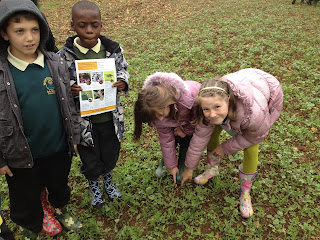John Clarke who has been helping with the conservation projects at Overbury is the first and maybe only guest blog writter to appear on Farmer Jake's blog. What he has to say is very inspirational and personally gratifying. To know that we as farmers can play a really big positive role in our countryside, wildlife and biodiversity. It's a message we have to share to the wider audience about what is great about British farming, growing food and expanding the wildlife we share our fields with.
As a Conservation Advisor, over the past few years I’ve been working closely with Jake Freestone, offering ideas for wildlife conservation and then monitoring the effect on wildlife. During that time Overbury Farms has gone through an exciting period of change as Government schemes have focused increasingly on wildlife conservation.
It is particularly rewarding as an advisor to see ideas and schemes bearing fruit and for me one of the most exciting aspects concerns field margins. There are a number of options for improving the wildlife value of this habitat – from putting them down to grass, planting a ‘meadow mixture’ of wildflowers and grasses, cultivating and planting with the main crop but leaving the margins unsprayed, planting them with a wild bird seed mixture – or a game crop – or just cultivating and leaving unplanted.
I love walking these margins, which often occur alongside footpaths, and recording all the birds, plants, butterflies – and many other forms of wildlife. I and other advisors love to see a situation where a range of these habitats are connected and planned to link with each other and a range of different wildlife habitats.

The aerial picture taken by Andrew John shows a good example of what is possible. Running across the area is an old embankment. With its rough grassland top, scrubby sides, wet ditches, scattered trees and some bare ground along the track it is a wildlife oasis in itself. However, its value has been increased hugely by what Jake has created around it. A number of hedges converge on the area and these are being managed sympathetically for wildlife and make perfect wildlife corridors between here and other sites. You can see that alongside the hedges there are grass strips and then out from them are several large cultivated strips. Some of these are sown with wild bird feed mixtures, some as part of the crop but unsprayed and some as game crops. Note the small, brown patches in the cornfields. They are left unplanted in order to attract Skylark to nest there or in the adjacent crop. In the top of the picture there is a small hay meadow.

Imagine other mosaics of wildlife habitats, varying in content and type, stretching from the top of Bredon Hill to the low-lying land below. Well, that is what we have got here.
How do we know that it is working? Well, in simple terms: there are literally dozens of pairs of Skylark breeding across the farm, Lapwing nest in several areas while the hedgerows support breeding Yellowhammer, Linnet and Whitethroat. In the margins the old-fashioned cornfield wildflowers are making a comeback. In some margins we are trialling the introduction of rarer wildflowers. If you are walking on the hill in June listen out for the Skylark – and Meadow Pipit – and look out for unusual poppies, pansies, Night-flowering Catchfly (a campion) and perhaps the odd Cornflower. There are bees and butterflies feeding on flowers in both the arable and grass margins. We have even recorded Corn Bunting and Yellow Wagtail in these new habitats – rare breeding birds which are slowly being attracted back to the area.
How do I feel about the project? When I see the results of all that planning and preparation it is hugely satisfying. To make a comparison: I have often started what I hoped would be a great watercolour painting – but it never was! However, I now know what it would have felt like had I managed it. Farming for wildlife is possible and is much preferred to restricting nature conservation to a few Nature Reserves – isolated and possibly fragile. Here at Overbury, wildlife is managed on a landscape scale and I am proud to have been part of such a great project. Each time that I go out to survey the farm I find something new and exciting. I hope that governments continue to encourage Jake and others to support wildlife in a big way. It is perhaps regrettable that many of us know of these schemes but very few are aware of and enjoy what they can achieve.
John Clarke



























.JPG)
















.JPG)



